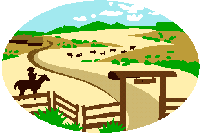
![]()
![]()
(These articles are part of PUMA's continuing series on the history of Magnolia Road and some of its longtime residents.)
Edith Scates has lived at mile 7 on Magnolia Road ever since she was born. In fact, many of our own homes are probably on land that originally belonged to Edith's father, Sherman William Scates. Sherman arrived on Magnolia, in 1887, when he was 16 years old. He had come from Missouri to help his pregnant aunt while his uncle worked the mines here. Sherman continued on to live, prosper, and eventually raise a family here. Though single women were scarce in those days, Eva May Wing, lived less than a mile away from the Scates ranch. When she was taken ill with pneumonia, it was Sherman Scates who was sent to Rollinsville on horseback to contact the nearest doctor. Thus began the lifetime partnership of Sherman William and Eva May Scates. When they married, Edith's father was 38 and her mother was 16 —the large gap in age is a reflection of how long a man would have to wait, in those days, to find a young woman willing to marry!
 By the time Edith and her younger brother Dick
arrived, her father had bought out many of the other homesteaders
and had acquired 3100 acres. Both children were delivered on the Scates'
Ranch, Edith by a midwife and Dick unassisted. For the first
few years, the family lived in a small cabin that is now used as
a storage building. The log-cabin, where Edith spent most of her
life and which can be seen from Magnolia Road, was built
in 1920 with logs that were brought by horse-drawn wagon
from Tolland and Jenny Lind Gulch near Rollinsville.
By the time Edith and her younger brother Dick
arrived, her father had bought out many of the other homesteaders
and had acquired 3100 acres. Both children were delivered on the Scates'
Ranch, Edith by a midwife and Dick unassisted. For the first
few years, the family lived in a small cabin that is now used as
a storage building. The log-cabin, where Edith spent most of her
life and which can be seen from Magnolia Road, was built
in 1920 with logs that were brought by horse-drawn wagon
from Tolland and Jenny Lind Gulch near Rollinsville.
While she was growing up, Edith's parents made their living by cattle ranching, cutting timber for the thriving gold, silver and tungsten mines nearby, growing oats for hay, and farming potatoes. The family was self-sufficient with chickens, milking cows, and a large vegetable garden. Life on Scates' Ranch was simple, but demanding. The Scates did not have electricity or running water while Edith and Dick were growing-up. Edith still remembers the difficulty of hauling well water up the hill to their home. Edith and her brother attended school at the nearby Pine Glade Schoolhouse, located where the Boy Scout Trails are today (the original schoolhouse was relocated and remains near the old Nederland Elementary School). Edith and Richard enjoyed their small classes, never more than four students, but, according to Edith, were unable to get away with any goofing off as a result! However, Edith says that the teachers never stayed more than a year since they were quickly married off to the anxious and lonely bachelors living in the area.
Edith remembers dances at the old Magnolia Townsite with her neighbors the Scohys. She would dance the waltz and the two-step, and, if enough people were around, enjoy a square dance as well. The parties often kept Edith out as late as 4:00 a.m. and drew revelers from as far away as Pinecliffe.
Edith left the ranch for only a short time in her early 20s when she worked as a typesetter at Coors in Golden. In 1942, after her father died, she returned home to help her mother and brother run the ranch. Her mother did most of the cooking and housework, while Edith and Dick cared for the cattle, cut and stacked the hay, and took care of the business end of the ranch. In 1969, Edith and Dick sold 3,000 acres of their land because of financial hardship and the difficulty of obtaining grazing permits from the US Forest Service. Edith currently spends her winters in Mesa, Arizona, and her summers on Magnolia. She remains, since 1930, an active member of the Presbyterian Church in Nederland.
Although Edith no longer ranches the remaining 100+ acres herself, she leases her pasture and sells her hay to Marie Mozden, another Magnolia rancher;. thus, cattle can still be seen grazing near Edith's house, just as they did 100 years ago.
Scates' Ranch is designated a Centennial Farm because it has been worked for over 100 years by the same family.
![]()
 Magnolia Memories: Flo Scohy
Magnolia Memories: Flo ScohyHave you ever wondered what Magnolia Road was like fifty or sixty years ago? Or why there is a large orange dinosaur of a crane at mile 2.7? Well, one vibrant member of our community has the answers to those questions and many more. Flo Scohy, longtime Magnolia Road resident and local historian, was kind enough to share some of her Magnolia memories with PUMA as a way to learn more about the history of our community and its many special residents.
In the 1930's, when gold and silver mines were flourishing, there were two small settlements on Magnolia Road - the upper and lower camps. In 1935, Flo's parents moved into the upper camp (mile 2.8), the more respectable of the two. The lower camp, with its saloon and dance hall was regarded as the shady side of town. In contrast, the schoolhouse, the post office and a few homes gave the upper camp a more esteemed reputation.
Further up the road, around mile 4, was a third mine site: the Kickyunca Mine. The turn-off site that we often use to enjoy the views of the Indian Peaks Wilderness Area was, at that time, dump site for the Kickynunga Mine's aerial tram!
 When her father assumed operation of the
mill hoist at the Bensie (upper) Mine, only two or three
other families lived at that site. A small number in comparison
to Magnolia's heyday; in 1898, over 2,000
people lived at Bensie, Magnolia's most lucrative mine.
When her father assumed operation of the
mill hoist at the Bensie (upper) Mine, only two or three
other families lived at that site. A small number in comparison
to Magnolia's heyday; in 1898, over 2,000
people lived at Bensie, Magnolia's most lucrative mine.
His hard work allowed Flo's parents to buy a $100 log home big enough for Flo, and her four brothers and sisters. Flo remembers newspapers dating back to 1876 covering the walls of their home. Once, due to the peculiar habits of the postmistress next door (burning long pieces of wood in the stove with the door open), Flo's home nearly burned down.
Some of Flo's fonder memories include family trips down the dusty, rutted road to Boulder to connect their radio to a battery so the whole family could listen to Fibber McGee and Molly.
Flo and her sister Jeanne Anne were the last two students to attend school at the small, one-room school house. Concerned about the lack of social interaction, Flo's parents moved the family to Boulder in 1943, when Flo was in third grade. (At that time, the one-room schoolhouse was moved to Nederland, where it still remains.) However, the move to Boulder did not prevent Flo from frequent return hikes to her beloved mountains and her family's Magnolia cabin; she spent many weekends and summers there before going off to college.
Flo finally returned to upper Magnolia in 1960 and has been living there, next door to her family, ever since. When her two brothers reopened the Bensie Mine in the late 70's and moved a large orange crane to the site, Flo ran the mill, which broke down the extracted material into concentrate and conducted assays to ascertain the amount of gold and silver present.Unfortunately, the difficulty and expense of the operation forced the Scohy's to cap the mine.
You might have a chance to meet Flo, or perhaps you've already heard some of these stories if you have picked up Flo hitchhiking down to Boulder, a courtesy for which she is especially thankful.
![]()
 Community
Members Help the Forests to Thrive
Community
Members Help the Forests to ThriveAlthough the Kelloggs have not been on Magnolia Road for quite as long as Edith Scates and Flo Scohy, they have been working to preserve the integrity of their forests for over 30 years. Since 1965, when Kelloggs purchased the western-most 200 acres of the Scates Ranch, they have actively participated in the care and preservation of their land. Central to this stewardship has been their partnership with the American Tree Farm System (ATFS), the Colorado Tree Farm Committee, and the National Forest Service.
Family patriarch Will Kellogg is proud to say his family has "worked closely with Craig Jones (regional forester) and the Colorado Tree Farmers to preserve our land. It has meant extra work and time but the results are worth it. We've gotten enormous satisfaction from working in the forest itself."
The first step the Kelloggs had to take was to develop a long-term plan; this they did with Jones' help. With that original plan as a benchmark, the Kelloggs and Jones assess the land each year, then take the necessary steps to grow, harvest, and renew the forest's resources. This includes thinning trees, removing unhealthy or diseased trees, harvesting designated trees for firewood or lodgepole fencing, and even replanting when necessary.
Valuable Benefits
This may seem like a lot of work, but the returns are high. The dollar and cents benefits are clear: a land owner stands to profit from the sale of harvested timber for firewood or lumber and may be eligible for reduced real estate taxes. More importantly, tree farming helps to aid the forest in its own natural growth process. As we learn more about the increasing fire danger that has resulted from recent decades of poorly managed forests and suppressed burns, the benefits of tree farming seem to get even greater.
Most importantly, a healthy forest will be able to sustain itself for generations and provide years of enjoyment. Just ask the Kelloggs. As one of the area's largest tree farmers and Colorado Tree Committee's "Tree Farmer of the Year", they have over 200 acres of thriving forest and a large, lush meadow to prove it!
To find out more about tree farming you can visit our article: Tree Farming: How it Works in PUMA's Mountain Living Section.
![]()